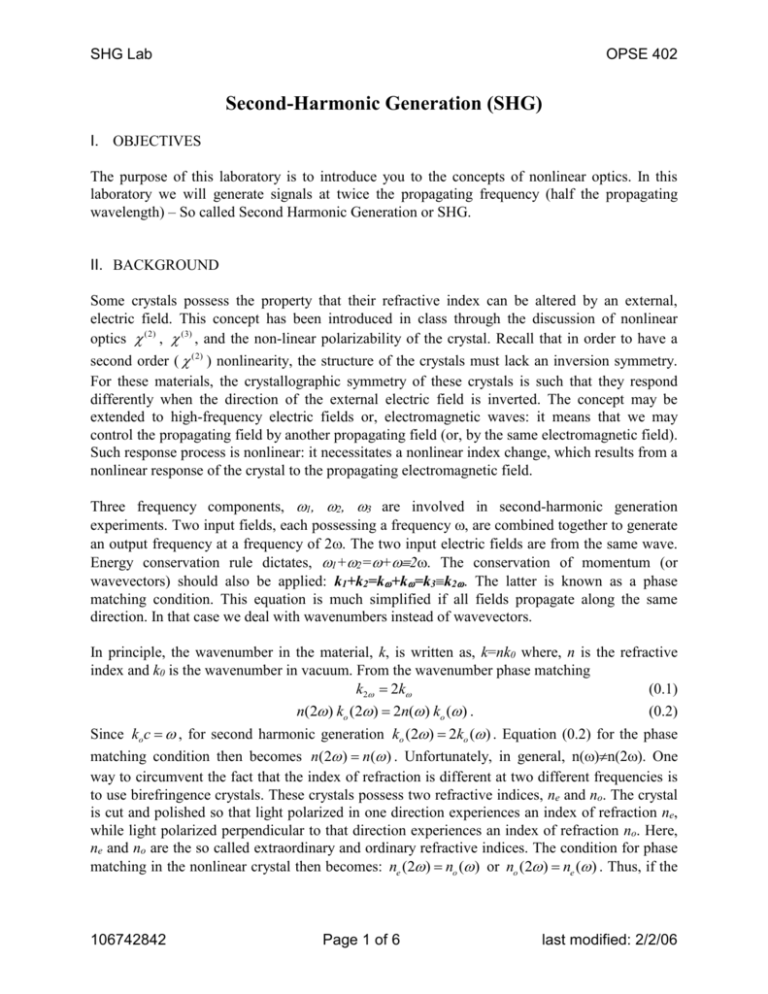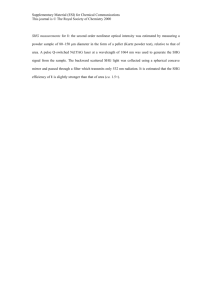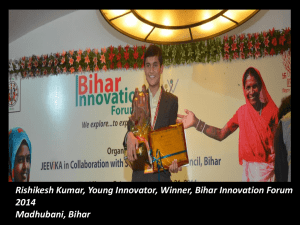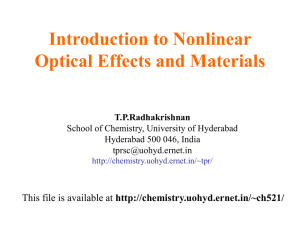secon harmonic generation
advertisement

SHG Lab OPSE 402 Second-Harmonic Generation (SHG) I. OBJECTIVES The purpose of this laboratory is to introduce you to the concepts of nonlinear optics. In this laboratory we will generate signals at twice the propagating frequency (half the propagating wavelength) – So called Second Harmonic Generation or SHG. II. BACKGROUND Some crystals possess the property that their refractive index can be altered by an external, electric field. This concept has been introduced in class through the discussion of nonlinear optics (2) , (3) , and the non-linear polarizability of the crystal. Recall that in order to have a second order ( (2) ) nonlinearity, the structure of the crystals must lack an inversion symmetry. For these materials, the crystallographic symmetry of these crystals is such that they respond differently when the direction of the external electric field is inverted. The concept may be extended to high-frequency electric fields or, electromagnetic waves: it means that we may control the propagating field by another propagating field (or, by the same electromagnetic field). Such response process is nonlinear: it necessitates a nonlinear index change, which results from a nonlinear response of the crystal to the propagating electromagnetic field. Three frequency components, 1, 2, 3 are involved in second-harmonic generation experiments. Two input fields, each possessing a frequency , are combined together to generate an output frequency at a frequency of 2. The two input electric fields are from the same wave. Energy conservation rule dictates, 1+2=+2. The conservation of momentum (or wavevectors) should also be applied: k1+k2=k+k=k3k2. The latter is known as a phase matching condition. This equation is much simplified if all fields propagate along the same direction. In that case we deal with wavenumbers instead of wavevectors. In principle, the wavenumber in the material, k, is written as, k=nk0 where, n is the refractive index and k0 is the wavenumber in vacuum. From the wavenumber phase matching (0.1) k2 2k (0.2) n(2 ) ko (2 ) 2n( ) ko ( ) . Since ko c , for second harmonic generation ko (2 ) 2ko ( ) . Equation (0.2) for the phase matching condition then becomes n(2 ) n( ) . Unfortunately, in general, n()n(2). One way to circumvent the fact that the index of refraction is different at two different frequencies is to use birefringence crystals. These crystals possess two refractive indices, ne and no. The crystal is cut and polished so that light polarized in one direction experiences an index of refraction ne, while light polarized perpendicular to that direction experiences an index of refraction no. Here, ne and no are the so called extraordinary and ordinary refractive indices. The condition for phase matching in the nonlinear crystal then becomes: ne (2 ) no ( ) or no (2 ) ne ( ) . Thus, if the 106742842 Page 1 of 6 last modified: 2/2/06 SHG Lab OPSE 402 field at frequency is launched with one polarization state, we expect that the second harmonic signal will be generated with a polarization state normal to incoming light polarization. II. EXPERIMENT You will be supplied with the followings: 1. Safety glasses. – THESE MUST BE WORN WHEN YOU ARE IN THE LAB. 2. A mounted nonlinear crystal. 3. An infrared laser. 4. Lens 5. Polarizers. 6. Detectors. 7. Dichromatic beamsplitter. 8. Infrared Blocking Filter (glass) 9. Neutral Density Filters (glass) 10. Beam dumps. III. TESTING For this experiment, you will set-up the experimental arrangement in two stages. Figure 1 illustrates the first stage. For this step, the most important condition is that the infrared laser beam be aligned so that it passes through the center of the crystal WITHOUT hitting the sides of the crystal. Use the infrared sensitive card and look at the laser beam profile before and after the crystal. It should look like a round dot at both locations. The mount for the crystal has 5 adjustments: an x and y position, two tilt adjustments, and 1 full rotation stage. Referring to Figure 2, mark the position of the infrared (IR) beam AFTER the crystal before inserting the lens (f~130mm). After inserting the lens, the IR beam should hit the some position. The efficiency of green light generation depends both on the frequency of the laser’s pulsing (more on this later) and the IR laser’s power. On the front panel of the laser control box, set the frequency for ~7 and the power at maximum (99). You can adjust these controls later to optimize the green light output. The output polarization of the laser is VERTICAL with respect to the tabletop. 106742842 Page 2 of 6 last modified: 2/2/06 SHG Lab OPSE 402 A. To generate green light, first rotate the crystal relative to the polarization of the incident infrared light (which is vertical) using the rotation stage in which the crystal is mounted. NOTE: You will generate green light ONLY when the crystal is rotated to the correct orientation. You will observe green light within about ±4 degrees of the optimum position, so rotate the crystal slowly while looking for green light. B. Once you observe some green light, place a photodetector (5mm by 5mm detection area) to detect the green light and monitor the output on an oscilloscope (use Channel 1). You will also need to filter out the IR radiation using the IR blocking filter. You will also have to attenuate the green light using neutral density filters. You should observe a waveform on the oscilloscope like the following: 0.9 Detector Signal (V) 0.8 0.7 0.6 0.5 0.4 0.3 0.2 0.1 0 0.0E+00 5.0E-07 1.0E-06 1.5E-06 2.0E-06 time (s) To properly trigger the scope, use the RF output on the back of the laser driver on Channel 2 of the oscilloscope. Trigger off of this “synchronization” signal on Channel 2. Ask your instructor to show you how to have the oscilloscope average several traces together and monitor the pulse amplitude. Note that the green light is not continuously on, but appears as bursts of light. You observe bursts of light because the laser itself produces bursts of light rather than a continuous stream of light. In other words, the laser is pulsed. Your next goal is to optimize the conversion efficiency to green light. 1) Using a 0.3ND glass filter, monitor the peak of the detected pulse on the oscilloscope while you place the filter in the path of the green light. The detected peak should decrease by roughly a factor of two. This simple test makes certain that the detector is in the linear range (voltage out proportional to power). 2) Using the photodetector to monitor the power of the green light, carefully adjust the rotation of the crystal to maximize the power. 3) Using the tilt adjustments, adjust the tilt (in two rotation directions!) to optimize the signal. 4) Iterate the procedure of adjustments until you no longer see an increase in the signal. 106742842 Page 3 of 6 last modified: 2/2/06 SHG Lab OPSE 402 C. Your next goal is to determine the power dependence of the SHG signal. Using ND filters, attenuate the infrared beam BEFORE the focusing lens. (NOTE: use glass filters. The plastic ND filters will melt.) For a given attenuation, measure the corresponding amplitude of the green light using the photodetector and oscilloscope. Use at least 5 different neutral density filter values between ND 0.1 and ND 1.0. Please note that the photodetector is sensitive to visible AND infrared light. In order to get an accurate determination of the power dependence, you need to determine the amount of IR light that passes through the IR blocking filter. To estimate this “background” value, remove all of the Neutral Density filters from BEFORE the focusing lens. Using a white piece of paper to monitor the amount of green light emitted, rotate the angle of the crystal until you no longer see any visible light. Monitor the voltage of the photodetector for this condition of no visible light. If your IR blocking filter is not removing all of the IR light, you will see a residual voltage on the photodetector. This is the “background” signal (from IR light) that must be subtracted from your data of C. To correct the data, use the following formula: Vcorr Vd Vb 10 ND (0.3) In this equation, Vd is the measured voltage of Part C. Vb is the “background” signal you just measured above, and ND is the Neutral density value of the filter. ND=0 corresponds to no filter present. The 10 ND correction is required since the “background” signal becomes smaller as you attenuate the IR light in Part C. D. Remove all the Neutral Density filters from BEFORE the focusing lens. Your next goal is to measure the conversion efficiency as a function of rotation angle of the crystal. Rotate the crystal ±15 degrees about the optimum angle in 1 degree increments or less. Record the measured power at each angular increment. E. From the discussion in the introductory section, the incident infrared light is polarized along one direction of symmetry of the crystal while the green light is polarized perpendicular to the infrared light. The Infrared laser light is polarized VERTICALLY. Using visible polarizers AFTER the dichromic beamsplitter, determine the polarization of the visible light relative to the table. Are the polarizations orthogonal? F. Measure the conversion efficiency of SHG. To due this, use the optical power meter to measure the amount of infrared power incident on the crystal. Next measure the amount of green power AFTER the dichromic beamsplitter. NOTE: You will probably need to attenuate the IR beam with a neutral density (ND) filter so that it is in the range of the optical power meter. Make sure that you note the value of any ND filters that you use. The conversion efficiency is Pg / PIR . (0.4) G. In part C, you measured the power dependence of the SHG signal for a pulsed IR laser. Now, you will modify the laser’s operation to lase continuously. On the front panel of the laser 106742842 Page 4 of 6 last modified: 2/2/06 SHG Lab OPSE 402 driver, there is a know to switch from internal modulation, to external modulation or no modulation. Using a white piece of paper in the path of the green light to monitor the amount of green light generated, turn the modulation control knob to “NO” modulation. The laser now is continuously on (no pulsing). How does the brightness of green light compare with the pulsed arrangement? Is it brighter or dimmer? H. Return the modulation control know to “internal”. In part C, you measured the power dependence of the SHG signal. Now, you will modify not the power of the infrared beam but the intensity (power/ area) of the infrared beam by focusing the infrared beam in the crystal. Using a white piece of paper in the path of the green light to monitor the amount of green light generated, remove the focusing lens. How does the brightness of green light compare with the focused arrangement? Is it brighter or dimmer? IV. Discussion and analysis A. B. C. D. E. F. G. From your data of IV.F, what is the conversion efficiency of SHG? From your data of IV.C, plot the magnitude of the SHG signal versus input power. Fit the data to a power law, ie. PSHG A PIR m where A is a constant. Determine the exponent m. Plot your data and fit on the same plot. From the theory we worked on in class, show that you expect that m=2. HINT: the power is proportional to the square of the electric field. Does your measured value match the theoretical value? From your data of IV.D, plot the measured SHG power versus rotation angle. Determine from your data the Full-Width Half Maximum (FWHM) value. This value is an estimate of how accurately you need to tune the rotation angle. From your observations of IV.E, what is the angle between the relative polarizations of the infrared and SHG signal? Is it 90 degrees? From your observations of IV.G, is the SHG light generated pulsed infrared light brighter or dimmer than with IR light which is continuously on? Assuming that the pulsed and non-pulsed modes of the laser emit the some AVERAGE power, briefly explain whether you expect the SHG light intensity to increase or decrease when you pulse the laser. From your observations of IV.H, is the SHG light generated by the focused infrared light brighter or dimmer than with unfocussed light? Using the theory that we have done in class, briefly explain whether you expect the SHG light to increase or decrease when you focus the infrared beam. 106742842 Page 5 of 6 last modified: 2/2/06 SHG Lab OPSE 402 Figure 1: Step 1 experimental arrangement for SHG. The SHG light will be faint. Make sure that the IR beam of light is not hitting the sides of the crystal. Figure 2: SHG with focusing of the infrared beam. The distance d should be equal to the focal length of the lens. The IR blocking filter is used to prevent the IR light from the detector. The neutral density filters are used to attenuate the green light so that the photodetector is not saturated (i.e. the detected voltage out should be proportional to the incident power. 106742842 Page 6 of 6 last modified: 2/2/06






